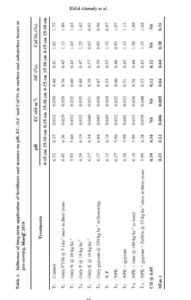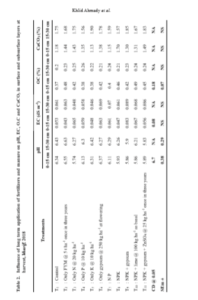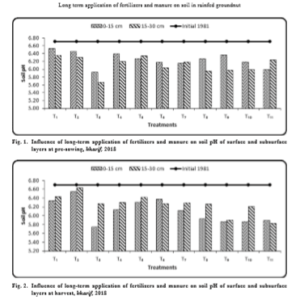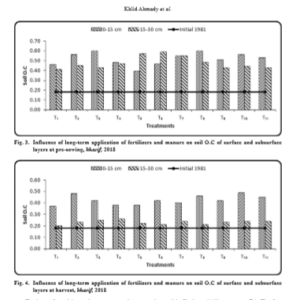EFFECT OF LONG TERM APPLICATION OF FERTILIZERS AND MANURE ON SOIL PHYSICO-CHEMICAL PROPERTIES IN RAINFED GROUNDNUT
0 Views
KHALID AHMADY*, K.V. NAGA MADHURI, P.V.R.M. REDDY AND S. HEMALATA
Department of Soil Science and Agricultural Chemistry, S.V. Agricultural College, ANGRAU, Tirupati, India – 517 502
ABSTRACT
An experiment on long -term application of fertilizers and manure was initiated in the year 1981 during kharif season at Regional Agricultural Research Station, Tirupati, Andhra Pradesh, India in rainfed groundnut monocropping system. The same experiment was used for the present investigation during kharif, 2018 season, to study the influence of long-term application of fertilizers and manure on soil physico-chemical properties. The experiment has eleven treatments each replicated four times in a randomized block design. The results revealed that the significant decrease in soil pH in all the treatments over initial soil pH. However, the decline was the highest in only N applied treatment and the lowest in FYM and control. The application of fertilizers and manure for 38 years increased the organic carbon content in all the treatments when compared with initial and highest content was with FYM application. Significant changes were not recorded with respect to EC and free lime content. However, ill effects were not find with respect to soil physic-chemical properties with the application of fertilizers and manure for 38 years.
KEYWORDS:
Long-term fertilizers application, Soil pH, EC, organic carbon, Lime content
INTRODUCTION
Long-term fertilizer experiments play an important role in understanding the changes in physical, physicochemical and chemical properties and productivity of the crop. The decline in soil fertility due to the imbalanced fertilizer use has been recognized as one of the most important factors limiting crop yield (Nambiar and Abrol, 1989). It is well recognized that long-term fertilizer experiments are repositories of valuable information regarding the sustainability of intensive agriculture. The LTFE serves as an important tool to understand the changes in soil properties due to intensive cropping and continuous use of fertilizers. Consistent use of fertilizers and manures in soil alters the physical, physico-chemical and chemical properties of the soil. Long- term fertilizer experiments are normally intended to show, how high production can be reached under different conditions and how far the soils are able to withstand depletion and deterioration.
Applying adequate amount of fertilizers is an important cultivation practice for getting yield and quality of crops, environmental protection and soil health sustainability. In addition, it is important to apply organic matter to cultivated soil on the basis of sustainability because cultivation enhances the rate of soil degradation and decomposition of soil organic matter. Long term application of ammonical nitrogen (N) fertilizers and urea caused several soil problems, such as lowering soil organic carbon content, acidifying soil and resulting in poor soil physical properties (Liu et al., 2010). These problems may partially be improved by applying organic amendments. Significant improvements in soil physical, chemical and biological properties have been reported due to organic matter application. Application of different organic fertilizers in combination with chemical fertilizers to agricultural lands is a popular practice in crop production. In Rayalaseema region of Andhra Pradesh, monocropping of groundnut under rainfed conditions in red sandy loam soils (Alfisols) is a common practice. Farmers of this region apply no fertilizers with the opinion that fertilizers will not be useful under rainfed conditions. Keeping the above facts in view, the present an experiment was initiated to study the changes in soil properties due to the long-term application of fertilizers and crop productivity at Regional Agricultural Research Station, Tirupati during kharif, 1981 under groundnut monocropping system. After 37 years of cropping, it was proposed to study in detail the effect of different treatments on soil properties. However, in the present study, the results on soil physico-chemical properties only were presented in this paper.
Long term application of fertilizers and manure on soil in rainfed groundnut
MATERIAL AND METHODS
Long-term fertilizers experiment at Regional Agricultural Research Station, Tirupati of Acharya N G Ranga Agricultural University (Andhra Pradesh) was started in the year 1981 to study the effect of continuous application of fertilizers and manure on rainfed groundnut grown on Alfisols. The same experiment was selected for the present investigation. The experiment involved 11 treatments each replicated four times in a randomized block design. The treatments include T1 : Control (no manure or fertilizers), T2 : Farm yard manure @ 5 t ha-1 (once in 3 years), T3 : 20 kg Nitrogen (N) ha-1, T4 : 10 kg Phosphorus (P) ha-1, T5 : 25 kg Potassium (K) ha-1, T6 : 250 kg gypsum ha-1, T7 : 20 kg N + 10 kg P ha-1, T8 : 20 kg N + 10 kg P + 25 kg K ha-1, T9 : 20 kg N + 10 kg P + 25 kg K + 250 kg gypsum ha-1 at flowering stage, T10 : 20 kg N + 10 kg P + 25 kg K + 100 kg lime ha-1 at flowering stage, T11 : 20 kg N + 10 kg P + 25 kg K + 250 kg gypsum ha-1 + 25 kg zinc sulphate ha-1 (as basal, once in 3 years). The nutrients NPK were applied through the fertilizers like urea, single super phosphate and muriate of potash. The farmyard manure and ZnSO4 were not applied in this season. The test crop was groundnut and variety selected was Dharani. The crop was sown on 16-07-2018 and harvested on 19-11-2018. The soil samples were collected at harvest at 0-15 cm and 15-30 cm as per treatments and analyzed for physico-chemical properties of soils as per standard procedures. The pH of the soil was determined in 1 : 2 soil-water suspension using Elico pH meter with a glass electrode as described by Jackson (1973). The electrical conductivity of the soil was determined in 1:2 soil-water extract with the help of Systronic digital electrical conductivity meter as described by Richards et al. (1954) and was expressed as dS m-1. The organic carbon content of the soil samples was estimated by the method given by Walkley and Black’s wet oxidation method as outlined by Jackson (1973) and was expressed in percentage. The free calcium carbonate content of the soil was determined by treating the soil with a known volume of standard HCl and back titrating the unused acid with standard alkali using bromothymol blue as an indicator (Piper, 1966). Data was analyzed statistically for test of significance following the Fisher’s method of analysis of variance as outlined by Gomez and Gomez (1984).
RESULTS AND DISCUSSION
Soil pH
The data on soil pH at pre-sowing and at harvest as influenced by various treatments in the long-term application for both surface and subsurface soils is presented in Table 1 and 2 and depicted in Figure 1 and 2. pH of the soil at pre-sowing was significantly influenced by various treatments used in the long-term experiment in both the surface (0-15 cm) and subsurface soil (15-30 cm). pH of the surface soil ranged from 5.92 to 6.53. The highest pH value was recorded in control (T1) (6.53) followed by FYM alone treatment (T2) (6.43) whereas the lowest value (5.92) was recorded in nitrogen alone treatment (T3). However, the pH of the subsurface soil at pre-sowing ranged from 5.66 to 6.35. The highest value (6.35) was recorded in control (T1) followed by K alone treatment (T5) (6.34) whereas the lowest was observed in N alone treatment (T3) (5.66).
The pH of soil at harvest was significantly influenced by different treatments in both the surface (0-15 cm) and subsurface soil (15-30 cm). pH of the surface soil ranged from 5.74 to 6.55. The highest pH value was recorded in FYM alone treatment (T2) (6.55) followed by gypsum alone treatment (T6) (6.37) whereas the lowest value was recorded in nitrogen alone treatment (T3) (5.74). The pH of the subsurface soil at harvest ranged from 5.83to 6.63. The highest pH value was recorded in FYM alone treatment (T2) (6.63) followed by control (T1) (6.43) whereas the lowest was observed in NPK + ZnSO4 + gypsum treatment (T11) (5.83).
Analysis of data at harvest shows a slight decrease in all the treatments in soil pH when compared to the initial (1981) soil pH (6.7) as shown in Fig 4.2. Application of FYM resulted in maintenance of the highest pH while only N treatment (T3) recorded the lowest pH when compared to all other treatments. This may be due to the acidifying effect of different chemical fertilizers and release of organic acids during decomposition of organic manures. Similar results of low pH due to fertilizer application to groundnut grown in sandy loam soils of humid and tropical climate of Meghalaya were attributed to oxidation of NH4+ and release of H+ ions (Lalfakzuala et al., 2008). Similar results were reported by Madhuri et al. (2017).

Long term application of fertilizers and manure on soil in rainfed groundnut
Electrical conductivity (dS m-1)
The data on soil EC at pre-sowing and at harvest as influenced by various treatments in the long-term experiment for both surface and subsurface soils is presented in Tables 1 and 2. EC of the soil at pre-sowing was not significantly influenced by various treatments used in the long-term experiment in both the surface (015 cm) and subsurface (15-30 cm). EC of the surface soil ranged from 0.029 to 0.045. The highest EC value (0.043) was recorded in N and P treatment (T7) (0.045) followed by gypsum alone treatment (T6) whereas the lowest value (0.029) was noticed in FYM alone treatment (T2). However, the EC of the subsurface soil at pre-sowing ranged from 0.028 to 0.044. The highest value (0.044) was recorded in NPK+gypsum+ Zn (T11) followed by gypsum alone treatment (T6) (0.038) which is on par (0.038) with N and P treatment (T6) whereas the lowest (0.028) was observed in FYM alone treatment (T2).
EC of the soil at harvest was also not significantly influenced by different treatments in the surface and subsurface soils. The EC of surface soil ranged from 0.043 to 0.083 dS m-1. The highest EC (0.083) was recorded in NPK+ gypsum (T9) and the lowest value (0.043) was recorded in FYM alone (T2). However, the EC of the subsurface soil ranged from 0.046 to 0.089 dS m-1. The highest value (0.089) was recorded in NPK+ gypsum (T9) whereas the lowest value (0.046) was recorded in the only K (T5). However, the trend of variation in EC of the soils between the treatments in both the soil layers was almost negligible and statistically non-significant (Table 1 and Figure 3). The same was observed when the values of EC obtained with different treatments as compared with initial value of EC (0.08) recorded at the starting of the experiment in the year 1981. This was supported by results of Shivashankar et al. (2018). Similarly, Salma et al. (2017) was also reported that the accumulation of salts was not observed due to continuous application of manure and inorganic fertilizers to rainfed groundnut over a period of 34 years in both the surface and subsurface soil layers.
Organic carbon (%)
Soil OC at pre-sowing and at harvest as influenced by various treatments in the long-term experiment for both surface and subsurface soils is presented in Table 1 and 2 and depicted in Figure 3 and 4. OC of the soil at presowing was significantly influenced by various treatments used in the long-term experiment in both the surface (015 cm) and subsurface soil (15-30 cm). OC of the surface soil ranged from 0.39 to 0.60. The highest OC value (0.60) was recorded in NPK treated plot (T8) which is on par with N alone treatment (T3) (0.60) followed by NPK + lime (T10) (0.56) and FYM alone (T2) (0.56). However, the lowest value (0.39) was recorded in K alone treatment (T5) and control (0.46) (T1). However, the OC of the subsurface soil at pre-sowing ranged from 0.41 to 0.59. The highest value (0.59) was recorded in gypsum alone treatment (T6) followed by K alone (0.57) treatment (T5) whereas the lowest (0.41) was observed in control (T1).
Soil organic carbon content at harvest was significantly influenced by the different treatments in the surface and was not influenced in the subsurface soil. The organic carbon content of surface soil ranged from 0.37 to 0.49. However, the highest value (0.49) was observed in NPK + lime (T10) followed by FYM alone (0.48) treatment (T2) and NPK (0.46) (T8) whereas the lowest (0.37) was observed in control (T1) followed by K alone (0.38) treatment (T5) and only gypsum (0.38) (T6).
With regard to the subsurface soil, the organic carbon ranged from 0.20 to 0.26. However, the highest value (0.26) was observed in only P treatment (T4) followed by N alone treatment (T3) (0.25) and on par with N and P (0.24) treatment (T7) and NPK + gypsum + ZnSO4 (0.24) treated plot (T11) whereas the lowest was observed in control (T1) (0.20) and gypsum (0.21) alone treatment (T6) and were on par with NPK treatment (0.21) (T8).
The above said data clearly indicated that the increase in organic carbon content in the surface soil as compared to the initial organic carbon content recorded in 1981 was mainly due to the accumulation of organic carbon over a period of time. This was in accordance with the findings of Singh et al. (1999) and Madhuri et al. (2017). The data also revealed that the organic carbon content was increased in all the treatments including control and fertilizer treatments. Similarly, Tiwari et al. (2002) also noticed from the long-term experiment conducted on Typic Haplustalf, that the continued application of fertilizers alone also helps in increasing the organic carbon content of soil, which could be attributed to higher contribution of biomass to soil in the form of crop stubbles and residues.



The data on free calcium carbonate content at harvest of soil was not significantly influenced by the different treatments in both the surface and subsurface soil layers. With respect to the surface soil at harvest, the free calcium carbonate content ranged from 1.13 to 1.70. However, the highest value (1.70) was observed in NPK (T8) followed by NPK+ gypsum+ Zn (1.49) (T11) and FYM alone (1.44) treatment (T2). Further, the lowest was observed in K alone (1.13) treatment (T5). The free calcium carbonate content of subsurface soil at harvest ranged from 1.56 to 1.90. However, the highest value (1.90) was observed in K alone treatment (T5) followed by NPK+ gypsum (1.85) (T9) and NPK+ gypsum+ ZnSO4 (1.83) (T11) whereas the lowest value (1.56) was observed in P alone treatment (T4). The results clearly indicated the lower content of calcium carbonate in all the treatments indicating Alfisols of Chittoor district had a low content of free lime. Similar results were earlier reported by), Parvathi et al. (2013).
The present study clearly showed that there is a decline in soil pH with the continuous application of fertilizers when compared to control and FYM application. There was a build up of organic carbon content in all the treatments including control due to continuous cropping over initial. There are no ill effects due to long-term application of fertilizers and manure with respect to soil physico-chemical properties over 38 years.
LITERATURE CITED
Gomez, A.K and Gomez, A.A. 1984. Statistical Procedures for Agricultural Research. John Willey and sons, New York, United States of America.
Jackson, M.L. 1973. Soil Chemical Analysis. Prentice Hall of India Private Limited, New Delhi.
Lalfakzuala, L., Kayang, H and Dhkar M.S. 2008. The effects of fertilizer on soil microbial components and chemical properties under leguminous cultivation. American-Eurasian Journal of Agricultural and Environmental Sciences. 3(2): 314-324.
Liu, E., Yan, C., Mei, X., He, W., Bing, S.H, Ding, L., Liu, Q., Liu, S and Fan, T. 2010. Long-term effect of chemical fertilizer, straw and manure on soil chemical and biological properties in northwest China. Geoderma. 158:174-154.
Madhuri, K.V.N., Reddy, P.V.R.M., Prasad, T.N.V.K.V and Krishna, T.G. 2017. Long-Term Effect of Fertilizers and Manures on ground Productivity and Soil Properties. In: Reddy, G.K., Reddy, P.V.R.M., Reddy, P.M., Reddy K.R and Krishna, T.G (eds). Recent advances in Groundnut production technology, 331-362. BS Publications New Delhi.
Nambiar, K.K.M and Abrol, I.P. 1989. Long-term fertilizer experiments in India (An overview). Fertiliser News. 34(4): 11-20.
Parvathi, E., Venkaiah, K., Naidu, M.V.S., Munaswamy, V., Reddy, K.B., Krishna, T.G and Prasad, T.N.V.K.V. 2013. Long-term effect of manure and fertilizers on the physical and chemical properties of an alfisol under semi-arid rainfed conditions. International Journal of Agricultural Sciences. 3(4): 500-505.
Piper, C.S. 1950. Soil and Plant Analysis. Academic press, New York, United States of America.
Richards, L.A., Allison, L.E and Borhestein. 1954. Diagnosis and Improvement of Saline and Alkali Soils. Oxford and IBH Publishing Company, New Delhi.
Salma, D., Venkaiah, K., Naidu, M.V.S and Ramu, Y.R. 2017. Long-Term effect of manure and fertilizers on yield and yield attributes of Groundnut (Arachis hypogae L.) under rainfed mono cropping system. Journal of Bulletin of Environment, Pharmacology and Life Sciences. 6(1): 348-353.
Shivasankar, C., Prasanthi, A., Naga Madhuri, K.V and Sunitha, N. 2018. Long-term effect of manure and fertilizers on soil physico-chemical and chemical properties in rainfed groundnut growing Alfisols. International Journal of Current Microbiology and Applied Sciences. 7(06): 2043-2050.
Singh, N.P., Sachan, R.S., Pandey, P.C and Bisht, P.S. 1999. Effect of a decade long fertilizer and manure application on soil fertility and productivity of rice – wheat system in a Mollisol. Journal of the Indian Society of Soil Science. 48(1): 72-79.
Tiwari, A., Dwivedi, A.K and Dixit, P.R. 2002. Long term influence of organic and inorganic fertilization on soil fertility and productivity of soybean – wheat system in vertisol. Journal of the Indian Society of Soil Science. 50(4): 472-475.
- Genetic Diversity Analysis of 64 Maize Inbred Lines for Yield Traits Using D2 Statistics and Principal Component Analysis
- Effect of Border Crops on Activity of Predatory Fauna In Blackgram (Vigna Mungo L.)
- Effect of Organic Nutrient Management Practices on Growth and Yield of Foxtail Millet
- Species Diversity of Sugarcane Shootborers in Major Sugarcane Growing Districts of Andhra Pradesh
- Faunistic Studies on Economically Important Lepidopterans in Different Field Crops of Tirupati District
- Production Potential of Sweet Corn as Influenced by Organic Manures and Foliar Nutrition

